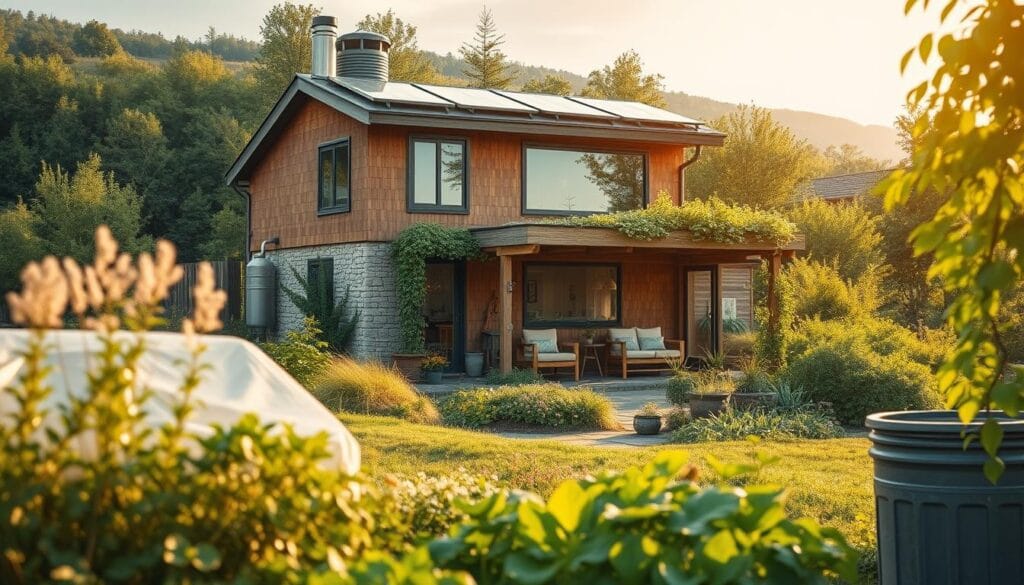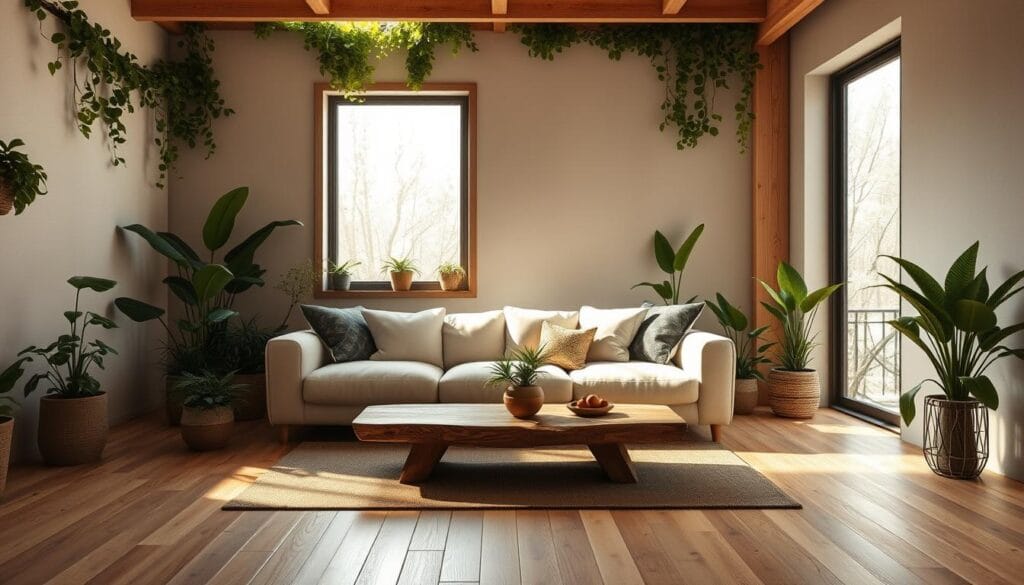Ever walked into a space that just feels right? That’s the magic of thoughtful design. Today, we’re reimagining how our living spaces can harmonize with the planet. With 30% of global emissions tied to the built environment, it’s time to make smarter choices.
2024 is all about blending style with sustainability. From reclaimed wood to energy-efficient systems, eco-friendly options are reshaping how we create. Imagine a space that not only looks good but also gives back to the environment.
Let’s explore how these trends can transform your space. Together, we’ll dive into innovative materials, smart systems, and designs that inspire. Ready to make your home a haven of sustainability? Let’s get started!
Introduction: Embracing Sustainable Home Design in 2024
Your living space can be both beautiful and kind to the planet. A sustainable approach to design makes this possible. It’s about creating a space that feels good to live in while reducing your environmental impact.
Understanding Sustainability in the Built Environment
Sustainability in the built environment means using resources wisely. From reclaimed wood to energy-efficient systems, every choice matters. This approach reduces waste and supports a healthier planet.
Proper insulation and renewable energy sources are key. They lower your carbon footprint and save money. Smart systems, like energy-efficient lighting, also play a big role.
Eco-Friendly Practices and Their Benefits
Eco-friendly practices are simple yet impactful. Adding plants improves indoor air quality. Using recycled materials in your decor is another great choice.
Here’s a quick look at some energy-efficient practices:
| Practice | Benefit |
|---|---|
| Solar Panels | Reduces reliance on fossil fuels |
| Rainwater Harvesting | Conserves water resources |
| Energy-Efficient Appliances | Lowers energy consumption |
| Recycled Materials | Minimizes waste |
These practices not only help the planet but also enhance your home’s functionality. For more ideas, check out these must-have features for a functional and stylish.
Embracing sustainability is more than a trend—it’s a way to make your home a true sanctuary. Every choice you make impacts the planet. Let’s create spaces that inspire and protect.
The Future of Home Design: Trends in Eco-Friendly and Green Living
Picture a place where innovation meets sustainability effortlessly. Modern spaces are evolving to reflect our values, blending style with eco-consciousness. Emerging trends are revolutionizing how we live, making it easier to create spaces that are both beautiful and kind to the planet.
One standout trend is the use of passive solar design. This technique maximizes natural sunlight to reduce heating costs by up to 50%. It’s a smart way to lower energy consumption while keeping your space cozy. Another game-changer is the integration of energy-efficient systems, like smart thermostats, which adjust heating and cooling based on household patterns.

Notable green buildings, like the Wilbat House, showcase how sustainable techniques can be both functional and stylish. From solar tracking systems to wind turbines, these designs prove that eco-friendly living doesn’t mean sacrificing aesthetics. They also highlight the importance of reducing carbon footprints through smart materials and layouts.
Interior design is also embracing sustainability. Think reclaimed wood paired with modern, energy-efficient technology. This blend of traditional and innovative materials creates spaces that are timeless yet forward-thinking. It’s about making choices that have a lasting impact on both your home and the environment.
Ready to update your space? Consider these trends when planning your next project. Whether it’s adding energy-efficient appliances or incorporating natural ventilation, every small change makes a difference. Together, we can create spaces that inspire and protect.
Eco-Friendly Materials Revolutionizing Interior Design
Transform your space with materials that tell a story. Sustainable choices are reshaping how we decorate, offering unique character while reducing waste. From reclaimed wood to innovative bamboo and cork, these options blend style with environmental responsibility.
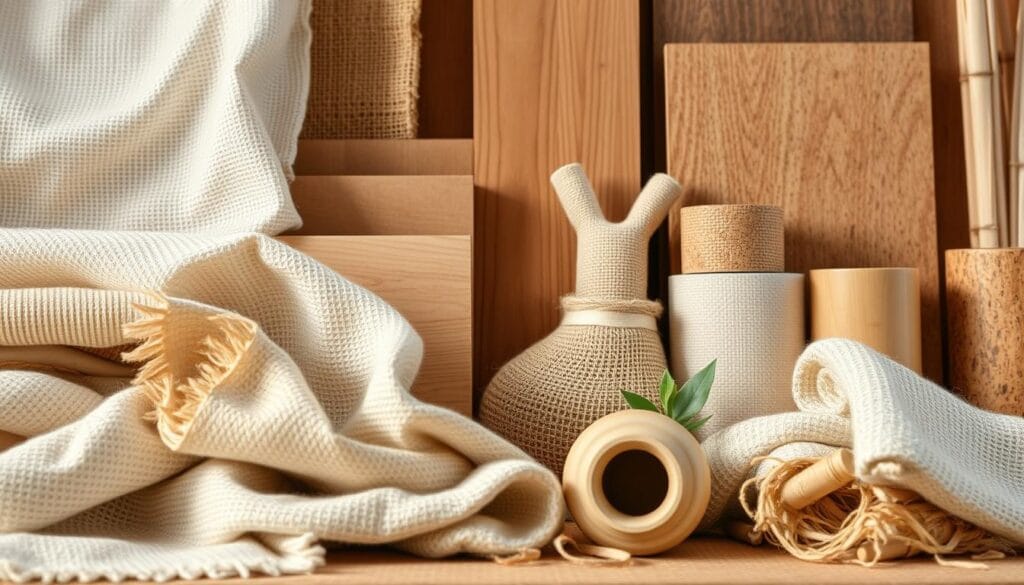
Reclaimed Wood, Bamboo, and Cork Innovations
Reclaimed wood brings history and warmth to any room. Each piece has a unique texture and story, making it a standout choice for flooring, furniture, or accent walls. It’s a sustainable practice that reduces the need for new timber.
Bamboo is another game-changer. Known for its rapid growth, it’s a durable and renewable resource. Perfect for flooring or furniture, it adds a modern touch while being eco-friendly.
Cork, harvested sustainably from cork oak trees, is gaining popularity. It’s soft underfoot, making it ideal for flooring. Plus, it’s naturally insulating and sound-absorbing, adding both comfort and style.
Low-Impact, High-Style Decorative Options
Decorative choices don’t have to harm the planet. Think recycled glass countertops or upcycled furniture. These items reduce waste while adding character to your space.
Here are some stylish, low-impact options to consider:
- Recycled metal accents for a sleek, industrial look.
- Natural fiber rugs made from jute or wool for a cozy feel.
- Low-VOC paints to enhance indoor air quality.
Every choice you make impacts the planet. By prioritizing sustainable materials, you create a space that’s both beautiful and kind to the environment.
Energy Efficiency and Water Conservation in Modern Homes
Creating a home that’s both stylish and sustainable is easier than you think. By focusing on energy efficiency and water conservation, you can reduce your environmental impact while enhancing your living space. Let’s explore how smart solutions and practical strategies can make a difference.
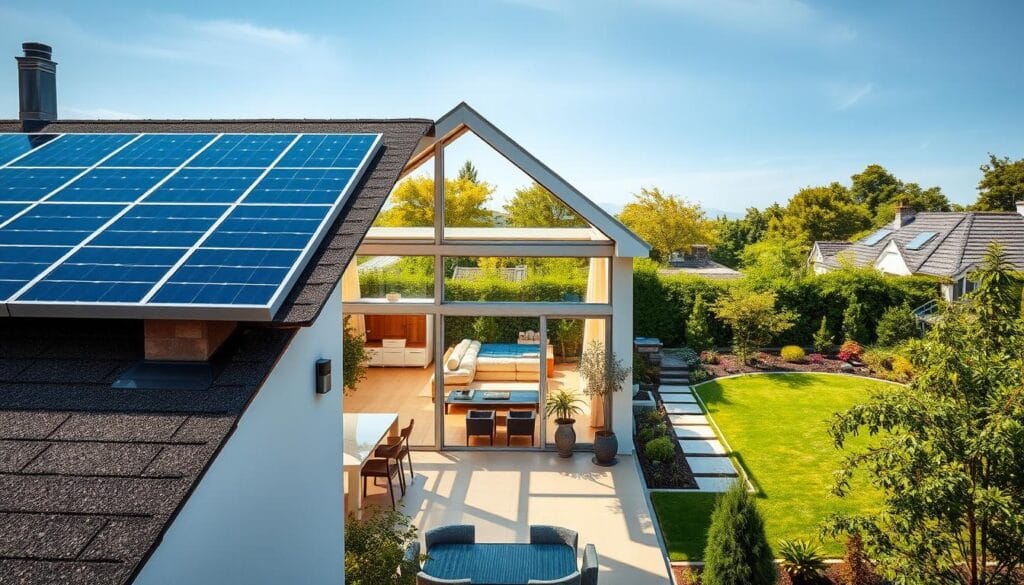
Smart Energy Solutions for a Lower Carbon Footprint
Innovative energy solutions are key to lowering your home’s carbon footprint. Smart thermostats, for example, optimize heating and cooling based on your habits. This reduces energy consumption and saves money on utility bills.
Integrating smart lighting systems is another great choice. These systems automatically adjust brightness and turn off lights in unoccupied rooms. This can cut energy use by up to 20%, making your home more efficient.
Here are some practical tips to reduce wasted energy:
- Upgrade to LED lights for long-lasting, energy-efficient lighting.
- Use programmable thermostats to optimize heating and cooling schedules.
- Unplug devices when not in use to avoid phantom energy drain.
Effective Water Management Strategies
Water conservation is just as important as energy efficiency. Low-flow fixtures, like faucets and showerheads, reduce water usage without sacrificing performance. Rainwater harvesting systems can also collect and reuse water for irrigation.
Here’s a quick look at some water-saving techniques:
| Strategy | Benefit |
|---|---|
| Low-Flow Fixtures | Reduces water usage by up to 50% |
| Rainwater Harvesting | Conserves water for outdoor use |
| Efficient Appliances | Lowers water and energy consumption |
These strategies not only conserve resources but also improve your home’s functionality. By adopting these practices, you can create a space that’s both beautiful and sustainable.
Innovative Building Techniques: Prefabrication and Reuse
Imagine building a space that’s both modern and mindful of the planet. Innovative techniques like prefabrication and material reuse are transforming how we create homes. These methods cut costs, reduce waste, and inspire creativity.
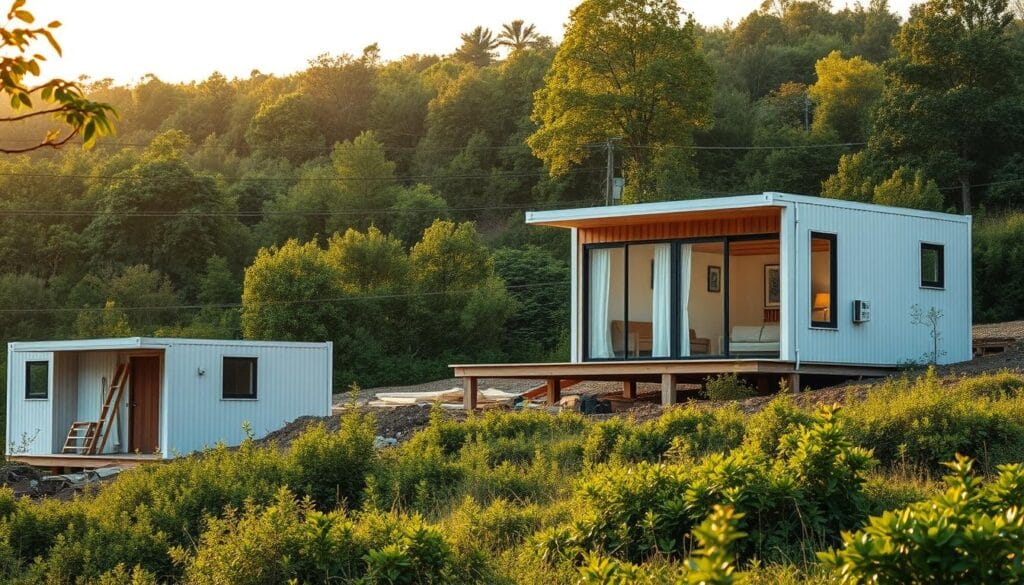
Modular Construction for Sustainable Innovation
Modular construction is redefining sustainable builds. This method involves creating sections of a home in a factory, then assembling them on-site. It’s faster, reduces physical waste, and ensures consistent quality.
Prefabricated components are designed with precision, minimizing errors and delays. This approach also lowers energy consumption during construction. “Modular homes are not just efficient—they’re a step toward smarter, greener living,” says a leading architect.
Repurposing Materials for Unique Living Spaces
Reusing materials is a creative way to minimize waste. Old bricks, wood, and metal can be transformed into chic interior elements. This practice adds character while reducing the need for new resources.
Here are some ideas to get started:
- Turn reclaimed wood into stylish shelving or accent walls.
- Use vintage bricks for a rustic fireplace or garden path.
- Repurpose metal items into unique decor pieces.
These choices not only save money but also make your space one-of-a-kind. Every item you reuse tells a story and contributes to a healthier planet.
Innovative building techniques are more than a trend—they’re a way to create homes that are both beautiful and sustainable. By embracing modular construction and material reuse, you can make a lasting impact.
Blending Technology with Eco-Living
Imagine a home where technology and sustainability work hand in hand. Smart devices are making eco-friendly practices more accessible and effective than ever. From energy-efficient lighting to automated systems, these innovations simplify life while reducing your environmental footprint.

Smart Home Devices Enhancing Sustainable Practices
Integrating smart home devices is a game-changer for sustainability. Energy consumption monitors, for example, track usage in real-time, helping you identify areas to cut back. Automated systems, like smart thermostats, adjust heating and cooling based on your habits, optimizing energy use.
Smart lighting is another standout feature. These systems not only enhance your interior design but also save energy by adjusting brightness and turning off when rooms are unoccupied. It’s a perfect blend of aesthetics and efficiency.
Here’s how modern devices can transform your space:
- Smart thermostats reduce energy consumption by up to 20%.
- Automated lighting systems cut electricity use while adding style.
- Energy monitors provide insights to help you make smarter choices.
Real-life success stories show the impact of these upgrades. One homeowner saved 30% on utility bills by integrating smart systems. Another created a cozy, eco-friendly atmosphere with automated lighting and energy-efficient appliances.
Ready to make a change? Start with subtle upgrades like smart power strips or energy-efficient bulbs. These small steps can yield significant results, improving your home’s functionality and reducing its environmental impact. For more inspiration, explore how technology is shaping modern spaces.
By blending technology with eco-living, you can create a home that’s both beautiful and sustainable. Every upgrade brings you closer to a greener future.
Indoor and Outdoor Integration: Biophilic Design and Air Quality
Step into a space where nature and comfort coexist effortlessly. Biophilic design is more than a trend—it’s a way to bring the outdoors inside, creating a healthier, more inspiring environment. By incorporating natural elements, you can improve indoor air quality and enhance your well-being.
This approach focuses on building a strong bond with nature. Think lush greenery, natural textures, and ample sunlight. These elements not only beautify your space but also promote mental clarity and reduce stress.
Maximizing Natural Light and Ventilation
Natural light is a cornerstone of biophilic design. Large windows and open layouts allow sunlight to flood your space, reducing the need for artificial lighting. This not only saves energy but also boosts mood and productivity.
Proper ventilation is equally important. Fresh air circulation helps maintain indoor air quality, reducing pollutants and allergens. Consider adding plants like snake plants or peace lilies, which are known for their air-purifying qualities.
Here are some practical tips to integrate biophilic design into your home:
- Use natural materials like wood and stone for furniture and decor.
- Add indoor plants to improve air quality and add vibrancy.
- Incorporate water features for a calming ambiance.
- Choose earthy colors and textures to create a cohesive look.
Smart systems can also enhance this approach. Automated lighting adjusts brightness based on natural light levels, while sensors monitor air quality to ensure a healthy environment. These technologies make it easier to balance comfort with sustainability.
By embracing biophilic design, you create a space that’s not only beautiful but also nurturing. Every choice you make—from the materials you use to the plants you add—contributes to a healthier, more harmonious world.
Multi-Functional Spaces for Sustainable Living
Discover how multi-functional spaces can redefine your living experience. These innovative designs not only maximize your home’s potential but also promote sustainability. By serving more than one purpose, they reduce the need for extra square footage, saving energy and resources.
Convertible Furniture and Open Floor Concepts
Convertible furniture is a game-changer for modern living. Imagine a sofa that transforms into a bed or a desk that folds into a wall. These items make it easy to switch from a workspace to a guest room in seconds. They’re perfect for small spaces or homes with limited square footage.
Open floor plans are another smart choice. They foster natural lighting and create a sense of fluidity. By removing walls, you can enhance airflow and make your interior feel more spacious. This layout is ideal for multi-purpose areas like combined living and dining rooms.
Here’s a quick look at the benefits of multi-functional design:
| Feature | Benefit |
|---|---|
| Convertible Furniture | Saves space and adds versatility |
| Open Floor Plans | Enhances natural light and airflow |
| Modular Design | Allows for easy reconfiguration |
Integrating modular materials into your home is another great idea. Think movable partitions or foldable tables. These items let you adapt your space to suit different needs, whether it’s hosting guests or working from home.
Optimizing your space also reduces energy and maintenance needs. Smaller areas require less heating, cooling, and cleaning. This makes multi-functional design not only stylish but also practical for sustainable living.
Ready to transform your home? Start with simple changes like adding a foldable desk or rearranging your furniture. Every small step brings you closer to a more efficient and inspiring space.
Eco-Conscious Luxury: Designing with Purpose
Luxury and sustainability can coexist beautifully in your space. By blending thoughtful design with eco-friendly practices, you create a home that’s both elegant and kind to the planet. Let’s explore how to achieve this balance.
Responsible Sourcing and Local Artisans
Choosing responsibly sourced materials is a cornerstone of eco-conscious luxury. Reclaimed wood, recycled metals, and natural fibers add character while reducing waste. These choices tell a story of sustainability.
Working with local artisans adds a personal touch. Their craftsmanship ensures high quality and supports communities. Every piece becomes a unique reflection of your values.
Timeless Elegance Through Sustainable Interiors
Timeless interior design focuses on durability and style. Opt for furniture made from sustainable materials like bamboo or cork. These options are not only eco-friendly but also add a modern touch.
Low-VOC paints and energy-efficient lighting enhance your home’s quality while reducing environmental impact. These small changes make a big difference.
Here’s how to create a luxurious yet sustainable space:
- Choose reclaimed wood for flooring or accent walls.
- Incorporate natural fibers like jute or wool in rugs and textiles.
- Use energy-efficient appliances to lower consumption.
By adopting this approach, you craft a home that’s both beautiful and ethical. Every detail reflects your commitment to sustainability.
Green Infrastructure: Walls, Roofs, and Solar Energy
Urban spaces can thrive with a touch of nature and innovation. Green infrastructure is transforming cities, blending sustainability with modern living. By integrating green walls, roofs, and solar systems, we create spaces that are both functional and eco-friendly.
Green Walls and Roofs as Urban Oasis Solutions
Green walls and roofs are more than just eye-catching features. They act as urban oases, improving air quality and reducing heat. Plants on walls and roofs absorb carbon dioxide, making cities cleaner and healthier.
Using sustainable materials like reclaimed wood and cork enhances these designs. These materials are durable, eco-friendly, and add a natural touch. They also reduce waste, making them a smart choice for modern construction.
Here’s how green infrastructure benefits urban living:
- Improves air quality by filtering pollutants.
- Reduces energy consumption by providing natural insulation.
- Creates habitats for urban wildlife, boosting biodiversity.
Solar Energy Systems for Sustainable Power
Solar energy systems are a game-changer for green infrastructure. They reduce reliance on conventional power, lowering energy bills and carbon footprints. Integrating solar panels with green roofs enhances their efficiency by cooling the surrounding air.
Real-life examples show the impact of these innovations. Toronto’s green roof bylaw has led to over 4 million square feet of green roofs since 2009. These projects not only beautify the city but also manage stormwater and reduce heat.
Key benefits of solar energy systems include:
- Lower energy consumption through renewable power.
- Enhanced efficiency when paired with green roofs.
- Long-term cost savings on utility bills.
By combining green walls, roofs, and solar systems, we create spaces that are both beautiful and sustainable. Every choice, from material selection to energy systems, impacts the environment. Let’s build a future where urban living harmonizes with nature.
Conclusion
Crafting a space that feels good and does good is within reach. By blending stylish design with eco-conscious practices, you create a home that’s both beautiful and kind to the planet. From energy-efficient systems to sustainable materials, every choice matters.
Smart technology, like automated lighting and thermostats, reduces consumption while enhancing comfort. Natural elements, such as bamboo and wood, add warmth and character. These items not only look great but also minimize environmental impact.
Experiment with multi-functional spaces and innovative design approaches. Convertible furniture and open layouts maximize use while saving resources. Every small change contributes to a healthier world.
Ready to transform your interior? Start with simple steps—add plants, choose low-VOC paints, or integrate smart systems. Together, we can create spaces that inspire and protect. Let’s make sustainable living a trend that lasts.


